- Quick Read
- Deep Read ( 5 Min. )

Why is Christian Science in our name?
Our name is about honesty. The Monitor is owned by The Christian Science Church, and we’ve always been transparent about that.
The Church publishes the Monitor because it sees good journalism as vital to progress in the world. Since 1908, we’ve aimed “to injure no man, but to bless all mankind,” as our founder, Mary Baker Eddy, put it.
Here, you’ll find award-winning journalism not driven by commercial influences – a news organization that takes seriously its mission to uplift the world by seeking solutions and finding reasons for credible hope.
Explore values journalism About usIn Today’s Issue
- As protests continue, cities juggle speech and safety concerns
- Adaptive farming comes to millennia-old crop: Olives
- DeSantis vs. Newsom: How Florida and California really stack up
- How 20th-century laws of war apply amid 21st-century crises
- Bring your appetite: Delicious documentary is a feast for the eyes
Monitor Daily Podcast
- Follow us:
- Apple Podcasts
- Spotify
- RSS Feed
- Download
TODAY’S INTRO
Henry Kissinger: A titan of modern diplomacy
 Mark Sappenfield
Mark Sappenfield
Your thoughts about Henry Kissinger very likely mirror what you think foreign policy is and does. The Nixon-era secretary of state died Wednesday, leaving a legacy as one of the preeminent diplomats of modern times. But that legacy is controversial, to say the least.
Is foreign policy a zero-sum game of bare-knuckle self-interest? Mr. Kissinger was an archetype of this realpolitik – winning rock-star status as “Super-K” but also vehement detractors. It’s not often a winner of the Nobel Peace Prize is also accused of abetting war crimes. Our review of a recent biography gives a nuanced portrait of the man.
Share this article
Link copied.

Help fund Monitor journalism for $11/ month
Already a subscriber? Login

Monitor journalism changes lives because we open that too-small box that most people think they live in. We believe news can and should expand a sense of identity and possibility beyond narrow conventional expectations.
Our work isn't possible without your support.
As protests continue, cities juggle speech and safety concerns
Protesters’ rights are protected by the United States Constitution. Residents’ desire for order and safety are protected by the police. Amid pro-Israeli and pro-Palestinian protests, cities are seeking a balance. New York’s Rockefeller Center tree lighting Wednesday offered a snapshot.

Rue, a nursing student from Brooklyn, joined hundreds of mostly young pro-Palestinian demonstrators waving flags and homemade signs on a frosty evening in Manhattan at the annual lighting of the Rockefeller Center Christmas tree.
Wednesday’s demonstration was the latest in a series of pro-Palestinian protests and acts of civil disobedience in New York and other cities. They are designed to draw attention to Israel’s deadly bombardment of Gaza since the Oct. 7 massacre and abduction of civilians in southern Israel by Hamas. In recent weeks, protesters have shut down bridges in New York and San Francisco and targeted cultural institutions. Several were arrested here last week after they glued their hands to the street to divert the annual Macy’s Thanksgiving Day Parade.
With Gaza temporarily becalmed by a weeklong cease-fire and hostage exchanges but with no end in sight to the larger conflict, the challenge of policing protests, and the risk of escalation, remains stark for law enforcement agencies. Few have faced sustained mass protests on this scale since the racial justice marches of 2020.
“There’s no easy way out of this,” says David Couper, a former police chief in Madison, Wisconsin.
As protests continue, cities juggle speech and safety concerns

It was a frosty night in midtown Manhattan, and Rue, a nursing student from Brooklyn, had joined hundreds of mostly young pro-Palestinian demonstrators, some clad in black-and-white keffiyeh scarves, waving flags and homemade signs. The occasion was the annual lighting of an 80-foot Christmas tree at nearby Rockefeller Center, a televised event featuring Kelly Clarkson and Cher that had drawn thousands of tourists to watch live.
To Rue, who declined to give his surname, it’s a bittersweet season. “I love Christmas too, and the Rockefeller tree, but this is about people’s lives,” he says. “People [here] seem so oblivious. They’re just going on with their daily lives as if people aren’t dying every day in Palestine.”
He breaks off to move a police barricade so more protesters can enter, and then adds, “I just want to make an impact, to show that we’re here and this is happening. People can’t just forget about it.”
Wednesday’s demonstration was the latest in a series of pro-Palestinian protests and acts of civil disobedience in New York and other cities. They are designed to draw attention to Israel’s deadly bombardment of Gaza since the Oct. 7 massacre by Hamas of 1,200 civilians in southern Israel and the abduction of about 240 hostages. In recent weeks, protesters have shut down bridges in New York and San Francisco, targeted Democratic lawmakers’ offices, and vandalized cultural institutions. Several were arrested here last week after they glued their hands to the street to divert the annual Macy’s Thanksgiving Day Parade.
With Gaza temporarily becalmed by a weeklong cease-fire and hostage exchanges but with no end in sight to the larger conflict, the challenge of policing pro-Israeli and pro-Palestinian protests, and the risk of escalation, remains stark for law enforcement agencies. Few have faced sustained mass protests on this scale since the racial justice marches of 2020 and must tread a balance between allowing peaceful speech, monitoring extremist groups, and keeping the public safe.
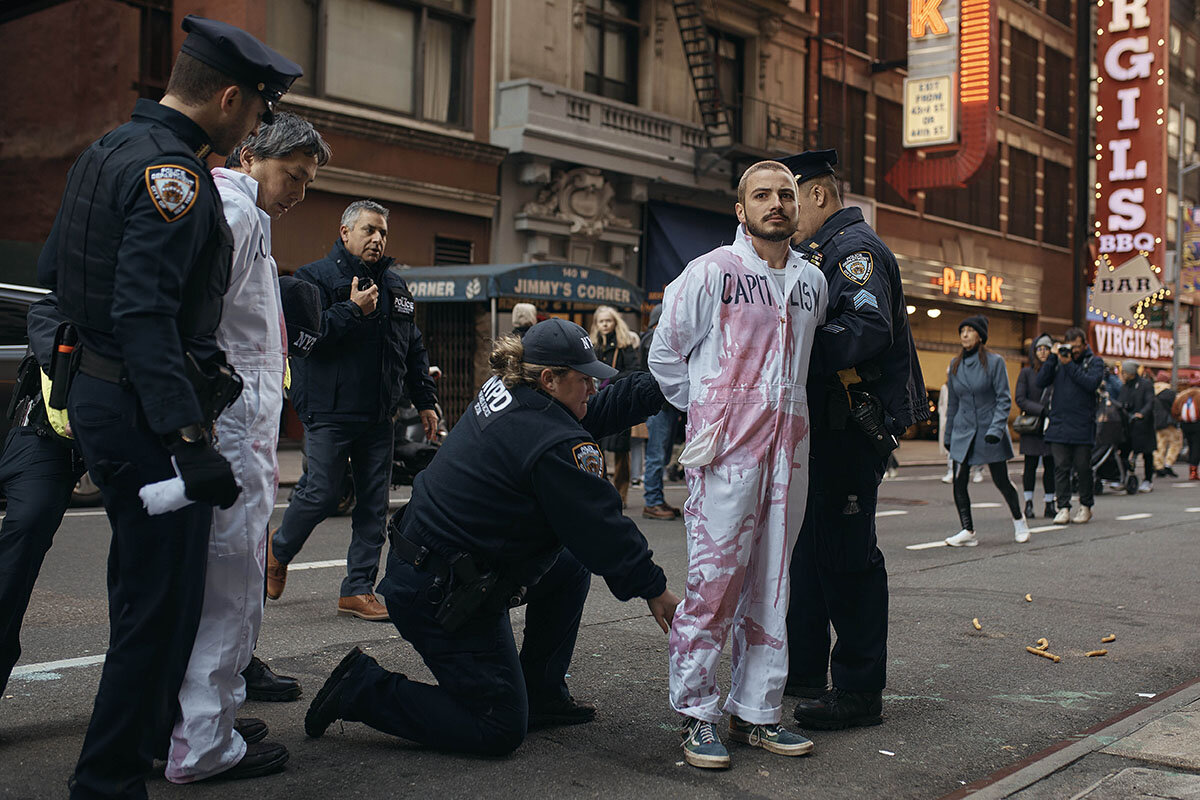
“This is the ebb and flow of protest. We try to keep it calm, we let people move, and we let them exercise their rights. Sometimes things get a little hectic,” Jeffrey Maddrey, chief of the New York Police Department, told CBS’ New York station during last night’s demonstration.
Protests and police presence
Earlier this week, Within Our Lifetime, a pro-Palestinian group that the Anti-Defamation League accuses of antisemitism, called for a “Flood The Tree Lighting for Gaza”; “Flood” was reportedly a Hamas code word for its Oct. 7 assault. “PRIESTS OF PALESTINE CALL FOR MOBILIZATION, NOT CELEBRATION!” it said on Instagram.
But a heavy police presence in and around Rockefeller Center prevented protesters from entering the cordoned tree-lighting area or disrupting the ceremony, which culminated at 10 p.m. in the lighting of 50,000 LED bulbs.
Instead, more than 500 protesters gathered by a Christmas tree outside the News Corp. building nearby, where a previous sit-down protest occurred. Later, the protesters marched for several blocks and some clashed with police, leading to several arrests with tensions running high but no major violence.
Experts say police officers nationally are wary of being drawn into prolonged confrontations with protesters that fuel tensions, particularly if counter-demonstrators show up to goad the other side.
As police chief of Madison, Wisconsin, from the 1970s to early 1990s, David Couper pioneered a managed response in which police worked with protest groups to set the bounds for actions so that they could voice their message lawfully. “It is a part of the Constitution: You have a right to peaceably assemble, so how do we make that happen? But that’s changed,” says Mr. Couper. “Once you lose the idea that the police really want to help and are not the villains ... the whole thing goes crazy. [In some cities] it’s a dangerous game. It’s a contact sport.”
Some speakers at Wednesday’s demonstration harangued the NYPD and called it complicit in Israeli killings of Palestinians, while protesters accused the police of making arbitrary arrests at past events. “It’s largely been peaceful,” says Rue, who has attended several in recent weeks. “But every once in a while, the police will swoop in and arrest people.”
Before the demonstration, the department laid down its ground rules. “The NYPD will be on hand to protect the tree lighting and all those attending, and we will not tolerate disruption or any threats to public safety,” said a spokesperson.
The nationwide protests after the police killing of George Floyd in May 2020 highlighted the broader challenge for law enforcement: Tasked with protecting public order, police can go overboard to protect their own when challenged, while protesters, in turn, push the boundaries of free speech in order to antagonize police. The upshot is a cycle of distrust that informs the next round, says Mr. Couper, who quit the police force in 1993 to become an Episcopal priest.
“Being able to police a diverse society requires that you have to be trusted and supported. Otherwise, the only way to do the job is more and more force,” he says.
Balancing free speech, hate, and safety
Among the protesters on Wednesday was Rivka Rosensweig, a community organizer in New York and a veteran of past Palestinian rights marches. “I’m here today because I think we are witnessing a genocide funded by the United States,” she says.
During the recent Israeli military actions in Gaza aimed at destroying Hamas, she has joined four protests in New York and two in Washington. Wednesday’s full-throated demonstration was encouraging, she notes. “I’d say, for turnout on a weekday it’s really good. It’s cold out.”
For most Jewish Americans and organizations that monitor hate speech, this wave of protests is far less encouraging. The FBI said last month that antisemitic threats to Jews were at a historic high. Not all threats are coming from pro-Palestinian militants, though; analysts say far-right groups continue to pose a greater threat to a minority that makes up 2% of the U.S. population. Officials have also reported an increase in threats against Arab and Muslim Americans since Oct. 7.
On Wednesday night, the crowd repeatedly chanted “From the river to the sea, Palestine will be free,” a slogan that to many signifies the expulsion of Israeli Jews from their country. Protesters also denounced President Joe Biden as “Genocide Joe,” underscoring the split on the left over the administration’s U.S.-Israel policy.
Ms. Rosensweig, who is Jewish, says her views are at odds with family members whom she describes as Zionists. She believes that everyone must take a stance on what is unfolding in Israel and the Palestinian territories. “Anyone, Jewish or not, with a conscience can see that what is happening is untenable and abhorrent.”
To Mr. Couper, the balancing act on protests isn’t getting any easier. When he ran Madison’s police department, he deployed officers to protect the rights of a small group of neo-Nazis to demonstrate near Wisconsin’s State Capitol. Last week, he watched as police were again on the streets in Madison to protect bystanders from a group of about 25 neo-Nazis, who shouted antisemitic and anti-LGBTQ slogans.
“There’s no easy way out of this,” he says.
Patrik Jonsson contributed reporting.

Adaptive farming comes to millennia-old crop: Olives
Signs point to one of the worst olive harvests on record. In Greece, this is no small thing. Farmers are bracing for a new normal. But the result is not resignation. Rather, it’s fresh thinking and approaches. “We don’t care about higher productivity,” says one. “We care about sustainability.”
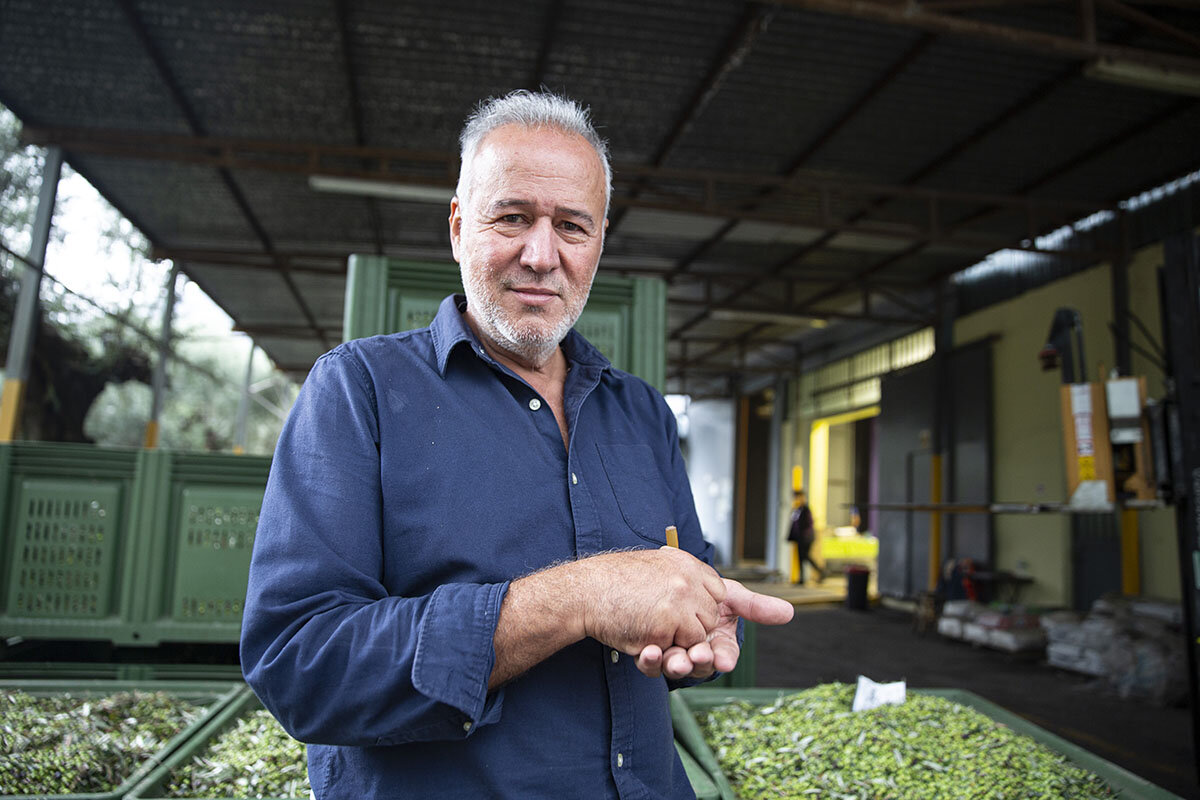
- Quick Read
- Deep Read ( 6 Min. )
One November day in Kalamata, Greece, as the community olive mill operates at full throttle, the rain outside turns to hail. A furious wind sways and snaps branches of the surrounding olive trees, some hundreds of years old, as a worker on a truck drops crate after crate of olives into an industrial crusher.
Climate change has been wreaking havoc on Kalamata’s olive crop this year. It endured winter conditions during the spring and experienced relatively low summer temperatures. That unusual weather, coupled with low rainfall, resulted in fewer and smaller olives. The region typically produces 45 thousand tons of olives per winter, but it expects less than 35 thousand tons this year.
But the mill is also representative of how Greek olive farmers are adapting. It is designed to run as sustainably as possible. Waste compost from the mill enriches the soil of the surrounding groves. It is the first mill in the region to rely on solar panel energy, and it recently secured a deal to sell electricity to the government.
“We want to adjust as soon as possible to the environment and be pioneers,” says Michael Antonopoulos, president of the Agricultural Cooperative of Kalamata. “Our place has to be fully ecological. We don’t care about higher productivity. We care about sustainability.”
Editor's note: The story has been updated to correct the amount of olives produced in the Kalamata region.
Adaptive farming comes to millennia-old crop: Olives
The olive tree, according to Greek mythology, was created by Athena, the goddess of wisdom, as a gift to the people of her namesake city, Athens. Olives and olive oil have become synonymous with Greece, and are credited, in part, with fueling the rise of Greek civilization.
But despite a history spanning thousands of years, these culinary pillars of Greek identity are under threat. Small farmers expect this year’s harvest season, which got underway in November, to be one of the worst years on record, thanks to climate change and the irregular seasonal shifts it has wrought upon the flowering process and fruit development.
“We are collecting olives much earlier than ever before. Our producers do not recall any year like this,” says Michael Antonopoulos, president of the Agricultural Cooperative of Kalamata. “I think we will see less and less olive trees not only in our region, but all the Mediterranean, because the Africa heat line is moving forward to Europe.”
He is not alone in expecting southern Europe to look like northern Africa in the span of 50 to 100 years. But Mr. Antonopoulos, a geologist and geotechnical environmentalist by training, is optimistic. He points to a series of steps that the community is taking to adapt to unseasonal temperature variations. “You can’t change the climate, but you can adjust,” he says.
And he notes that traditional olive groves have an important role to play in combating climate change. They are carbon sinks and could easily be integrated into carbon-offsetting projects, increasingly popular but also controversial methods used to reduce the carbon footprint of a company or country. Kalamata is among six Greek cities participating in the European Union mission for 100 climate-neutral and smart cities by 2030.
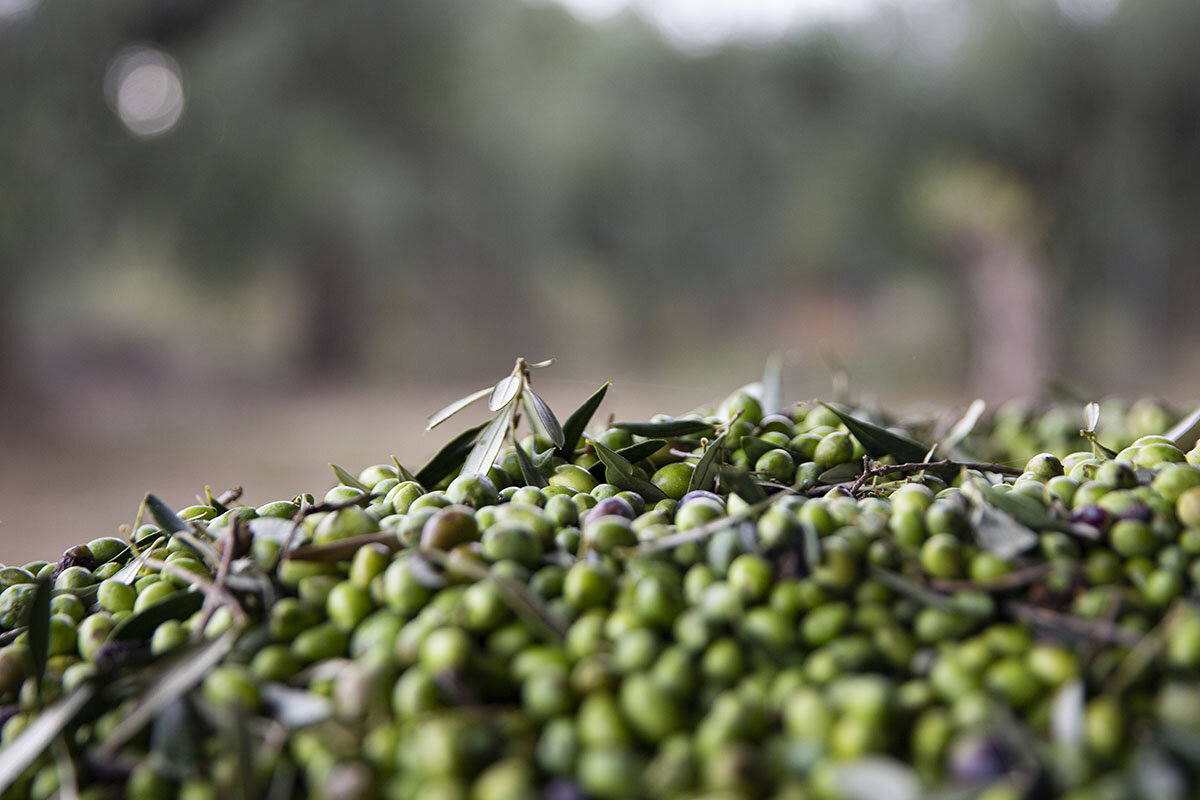
“We want to adjust as soon as possible to the environment and be pioneers,” he says. “Our place has to be fully ecological. We don’t care about higher productivity. We care about sustainability. We know people in the future will appreciate that more than anything.”
“We harvest in our T-shirts”
One November day in Kalamata, as the mill that serves a community of roughly 300 olive oil producers operates at full throttle, the rain outside turns to hail. A furious wind sways and snaps branches of the surrounding olive trees, some hundreds of years old, as a worker on a truck drops crate after crate of olives into an industrial crusher.
It’s been that kind of year for Kalamata’s olive crop. In 2023, it endured winter conditions during the spring and, unlike much of Greece, experienced relatively low summer temperatures. That unusual weather, coupled with low rainfall, resulted in fewer and smaller olives. The region typically produces 45 thousand tons of olives per winter, but it expects less than 35 thousand tons this year.
“If you don’t have certain weather conditions at a certain time,” explains Mr. Antonopoulos, “you can’t have olive oil.”
But the mill is also representative of how Greek olive farmers are adapting to the new environment. It is designed to run as sustainably as possible. Waste compost from the mill enriches the soil of the surrounding groves. It is the first mill in the region to rely on solar panel energy, and it recently secured a deal to sell electricity to the Greek government. Further, its farmers have adjusted their pruning tactics to optimize water use. And geothermal energy heats the olive oil extraction plants.
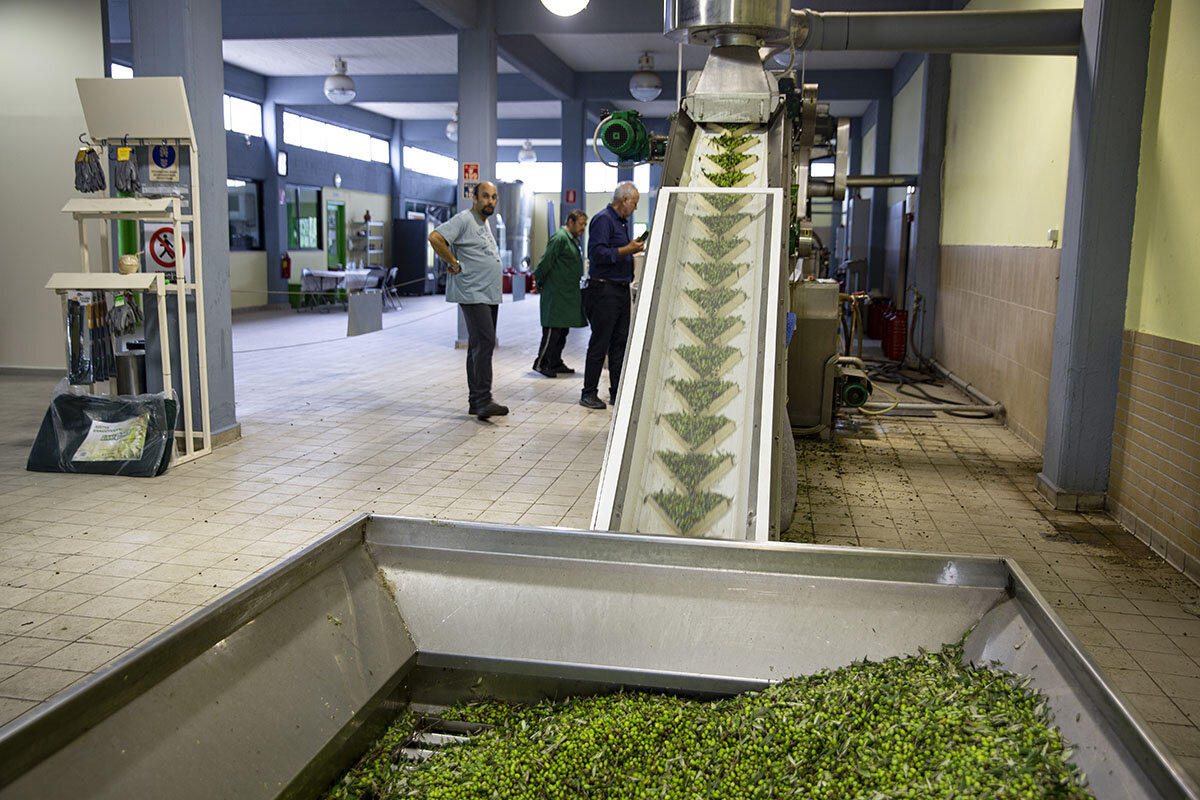
Long-term adaptive planning is also starting to bear fruit now. In 2012, the European Union launched the Olive Clima project in the region, testing climate change mitigation and adaptation techniques. It tweaked olive cultivation practices with an eye to reducing greenhouse gas emissions and increasing carbon dioxide capture.
“It’s all about feeding the soil,” says George Kokkinos, head of the Nileas olive oil producers cooperative in the broader Messenia region, which encompasses Kalamata. “Soil health is top priority.”
The measures promoted by the EU include the recycling of pruned olive tree material and mulch. Farmers adjusted pruning techniques to maximize contact with air and sun, used trimmed material for compost and improving soil health, and intermixed planting olive trees with legumes.
“The philosophy was to look at how olive tree cultivation adapts to climate change,” adds Mr. Kokkinos. “It was the first time that we heard of the expression ‘climate change.’ We had not yet seen any consequences related to climate change. The consequences only start to be seen and felt here in 2016.”
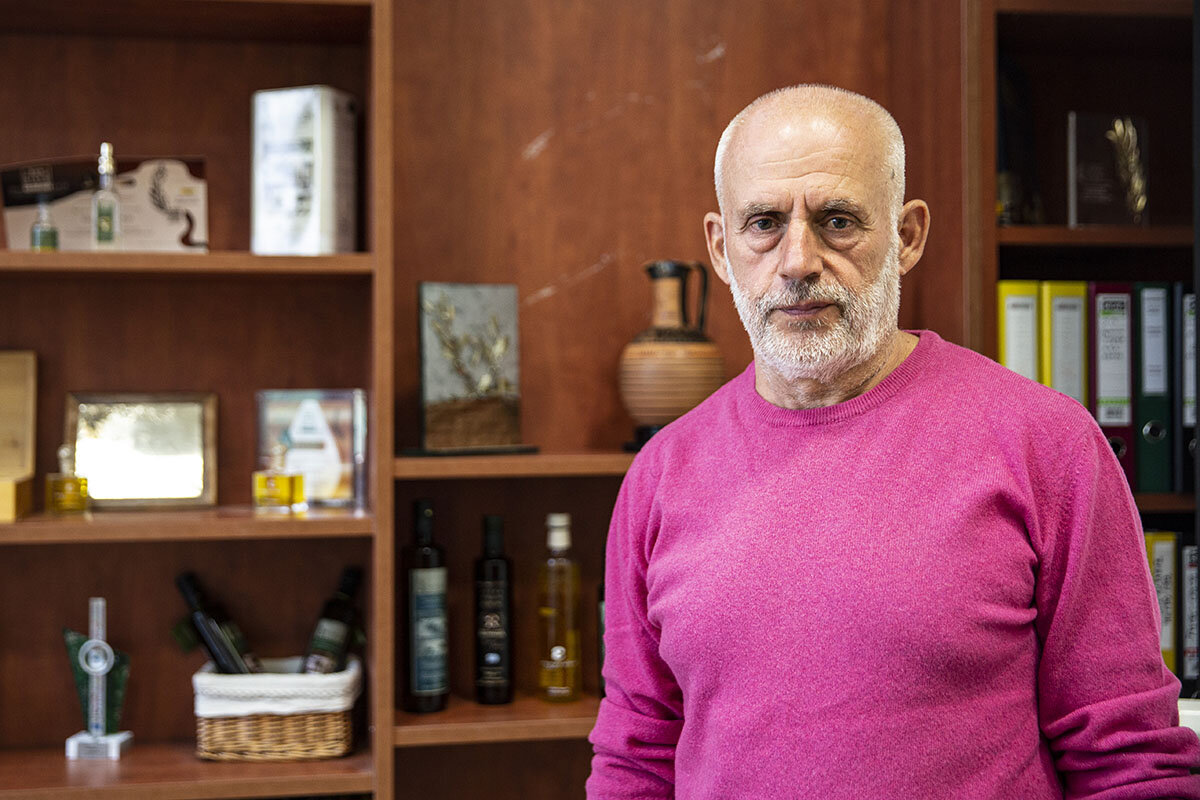
One of the most visible of these consequences, he says, are warmer, humid winters. This led to the spread of fungal diseases. Another change is the longer spring and the delayed onset of summer. June, he notes, became a moody month, with warm and cold spells. Summer now starts in July and lasts longer. All that confuses the olive tree, which decides in February whether to flower and delivers olives in April.
“We had 30 degrees Celsius here [86 degrees Fahrenheit] on Nov. 9,” he says, shaking his head. “That would have been unbelievable back in the 1990s. The normal, maximum temperature for this place this time of year would have been 16-18 C [60-66 F]. Typically, we would start the harvest wearing heavy clothes. Now we harvest in our T-shirts.”
The mitigation measures are working, he says, even though recent summer heat waves dried up the soil. He sees evidence of that in a 30% loss of productivity this year on his grove, compared with much higher losses among those who took no measures. The techniques they tested in the project now form part of the EU sustainable agricultural policy. But he worries that the Greek government is not prioritizing action and the spread of know-how to other farmers.
“The farmer stands in the middle and does not connect the dots,” he says. “The average farmer in Greece is 60 years old. It’s a hard time. That’s true. But there are opportunities. The key is to adjust.”
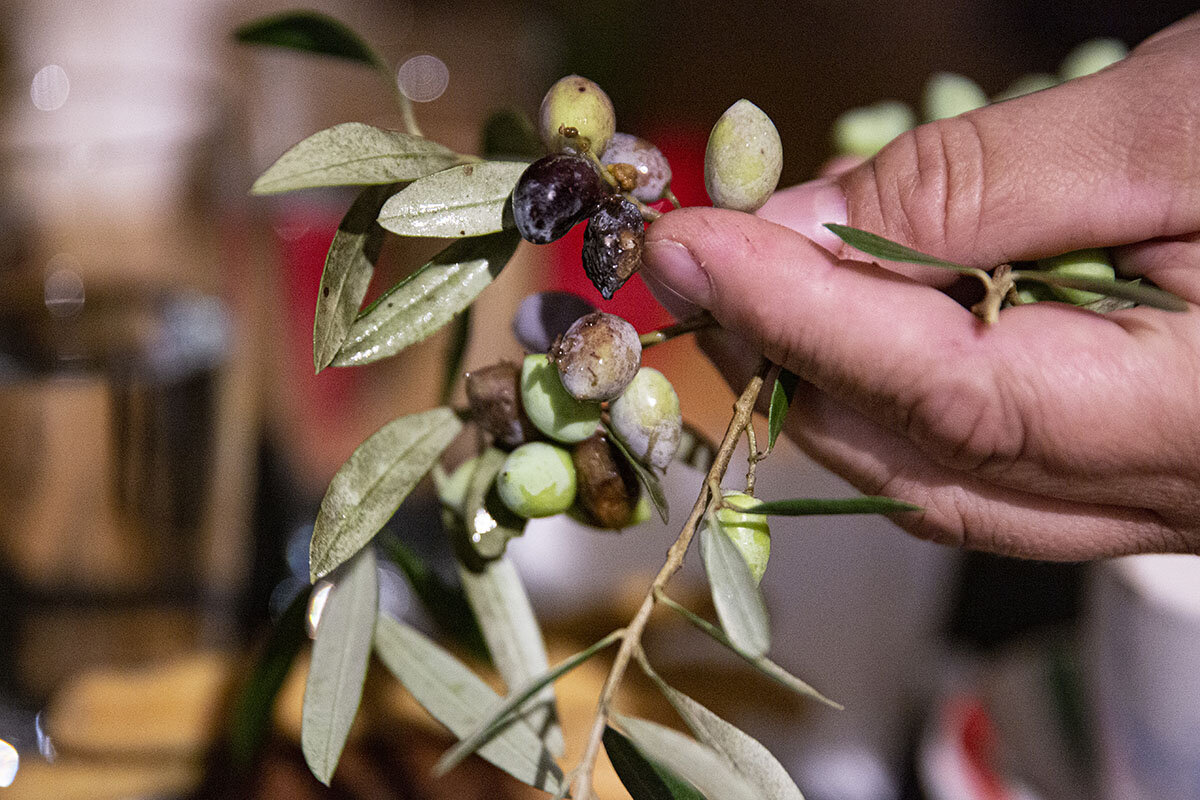
Giorgos Tzortzinis – a young olive grower and oil taster – used to be a climate change skeptic. Not anymore. “Before we would just hear about it,” he says. “Now we see it with our own eyes.” Productivity at his family grove of 2,000 trees has dropped by 60% year on year.
That loss is offset by unusually high olive oil prices as climate change hits Spain, the world’s main producer, where drought and extreme heat waves have devastated production. Last year, he says, his olives were fetching €4.50 per kilo ($2.24 per pound). Now it is almost double – about €8.
“Nature always finds a way”
Temperatures finally dropped to winter levels on the first day of Maria Mylona’s harvest in Messenia. The joy of picking olives was matched by the relief of finally being able to turn on the fireplace and roll out the winter carpets at her hillside home flanked by olive trees. The November day coincided with rain – a welcome development in a land that is drying up.
“The trees don’t have many olives, and the olives are not good due to the drought,” she complains, pouring out tea and sharing some homegrown figs with her guests. “We expect 50% losses. Our trees have just a few olives. They should be fat and round and green. But they are black and small.”
She and her husband have been battling the last six years against fungi, which grows in humid conditions. They consider themselves lucky because only 10% of their trees are affected. The fungi cannot be eradicated, only contained. They are also trying to use more gentle approaches to olive pickings. Long are the days when they would bang the trees with sticks to unload the olives. Now they shake them gently with mechanical tools.
The biggest blessing, she says, is to still have the possibility to raise her children in the shadow and scent of the olive tree. “I want them to have and treasure this memory,” she says. “My parents did that for me. The trees and nature will take their time, but in the end, they will adjust. Nature always finds a way to complete its circle and survive.”
Jenny Tsiropoulou supported reporting for this story.
Editor's note: The story has been updated to correct the amount of olives produced in the Kalamata region.

Graphic
DeSantis vs. Newsom: How Florida and California really stack up
Fox News is hosting a rock-’em, sock-’em debate tonight between two governors on opposite political ends, Florida’s Ron DeSantis and California’s Gavin Newsom. The topic: Which political approach is better, red or blue? We’ll let you decide, but here are some graphics that offer factual context for the partisan talking points.
Which state is doing better? That question is in the spotlight tonight as the governors of Florida and California – one red state and one blue state – go head to head in a nationally televised debate on Fox News.
They’re actually Sun Belt states with a lot in common: large populations; big tourist destinations, including a Disney resort; governors with presidential aspirations; and even a shared insurance crisis as disaster risks prompt insurers to pull out of both states. But economically and politically, the two states are headed in different directions under Govs. Ron DeSantis (Florida) and Gavin Newsom (California).
As our chart package today shows, typical Californians earn nearly 50% more than their Florida counterparts, are a bit better educated, and are more likely to have health insurance. Florida is the place where corporations head for a predictable, low-tax environment. Moreover, Florida’s population is growing; California’s is shrinking.
Politically, the two governors, who took office a day apart from each other in 2019, could hardly be more different. Mr. Newsom is a progressive Democrat who eagerly courts high-tech companies to come to the state. Mr. DeSantis espouses a hard-right populism and was once considered the leading candidate to replace Donald Trump, although the governor’s poll numbers in the current presidential race have fallen. – Laurent Belsie, staff writer

U.S. Census Bureau, Federal Reserve Bank of St. Louis, Pew Research Center, Ballotpedia, Tax Foundation, Global Data Lab, U.S. Bureau of Labor Statistics, Bankrate, FBI, CNBC, U.S. News & World Report, Fortune, Complex Effects, Guttmacher Institute, Giffords Law Center

Patterns
How 20th-century laws of war apply amid 21st-century crises
At the moment, the world is struggling to apply the landmark humanitarian standards crafted after World War II. So much has changed that those standards sometimes feel distant today. Yet looking below the surface reveals how a founding value has endured.

- Quick Read
- Deep Read ( 5 Min. )
Two major crises are presenting a values paradox. Humanitarian standards enshrined in two key international conventions after World War II have rarely seemed more relevant: the laws of war U.S. President Joe Biden has repeatedly cited in the conflict in Gaza, and the rules protecting refugees in search of asylum.
Yet the waging of war and the worldwide flow of refugees look almost unrecognizable from when the Geneva Conventions on protecting civilians in conflict were drafted in 1949, with the United Nations Refugee Convention following two years later.
Updating the conventions seems almost fanciful in the current geopolitical climate. But the humanitarian truce of recent days in Gaza could turn out to provide a broader model for at least starting to resolve the paradox.
The key in Gaza has been a coming together of the most directly affected parties to focus on what lies at the heart of both conventions: a duty to protect vulnerable civilians endangered by circumstances beyond their control. In Europe, rights groups will be watching closely to see if recognition of that core principle’s enduring power could also inform a more sustainable response on migrants.
How 20th-century laws of war apply amid 21st-century crises

If you’re reading this, chances are you’re already aware that Monitor writers around the world strive not just to report the news but also to convey the human stories underneath – and the human values that so often animate them.
Now, however, two major international crises – the war in Gaza, and a surge in migrants from Africa, the Middle East, and Asia desperately trying to enter Europe – are underscoring what might be called a values paradox.
On the one hand, the humanitarian standards enshrined in two key international conventions after World War II have rarely seemed more relevant: the laws of war U.S. President Joe Biden has repeatedly cited in the conflict in Gaza, and the rules protecting refugees in search of asylum.
Yet applying these decades-old commitments to the dramatically altered conditions of our 21st-century world is proving ever more complex and difficult.
The waging of war and the worldwide flow of refugees look almost unrecognizable from when the Geneva Conventions on protecting civilians in conflict were drafted in 1949, and when the United Nations Refugee Convention came into being two years later.
The prospect of bringing the world together to update them looks almost fanciful in today’s geopolitical climate. It’s marked by growing great-power tensions and a Global South increasingly determined to make its independent voice heard, while many democracies are increasingly preoccupied with angry political divisions at home.
Still, the human toll on both sides of the Israel-Hamas war and the plight of the refugees often risking their lives to cross the sea and land borders into Europe have refocused attention on those bedrock postwar conventions.

And while the war in Gaza seems far from over, the humanitarian truce of recent days could turn out to provide a broader model for at least starting to resolve the values paradox.
The key in Gaza has been a coming together of the most directly affected parties, each with its own interests, to focus on the principle at the heart of both post-World War II conventions: a duty to protect vulnerable civilians endangered by circumstances beyond their control.
The negotiators have set aside, at least for as long as the guns and rockets stay silent, the far thornier question of how to apply the laws of war to a conflict very different from the country-versus-country conflicts that prompted the Geneva Conventions.
The war in Gaza pits a national army against a guerrilla force that has embedded its command posts, arms, ammunition, and rockets in civilian areas and a maze of tunnels underneath.
On Oct. 7, Hamas abused, abducted, and killed hundreds of Israeli civilians. The Israelis, too, are facing accusations of war crimes in their bombardment and invasion of northern Gaza. Yet they maintain they’ve done all they can to get civilians to leave those areas, and that there’s no way of hobbling Hamas’ forces militarily without going after them where they are.
What is beyond dispute, however, is the civilian suffering on both sides.
That’s what led to the truce. It also explains reported U.S. moves to press Israel to adopt a more “targeted” approach if, as is expected, the fighting resumes.
The migrant influx
The “migrant crisis” confronting European governments is, in some ways, similar.
It, too, is nothing like the flow of asylum-seekers that led to the 1951 U.N. Refugee Convention, which sought to open doors for hundreds of thousands of Europeans left uprooted, fearful, and homeless in the wake of the world war.
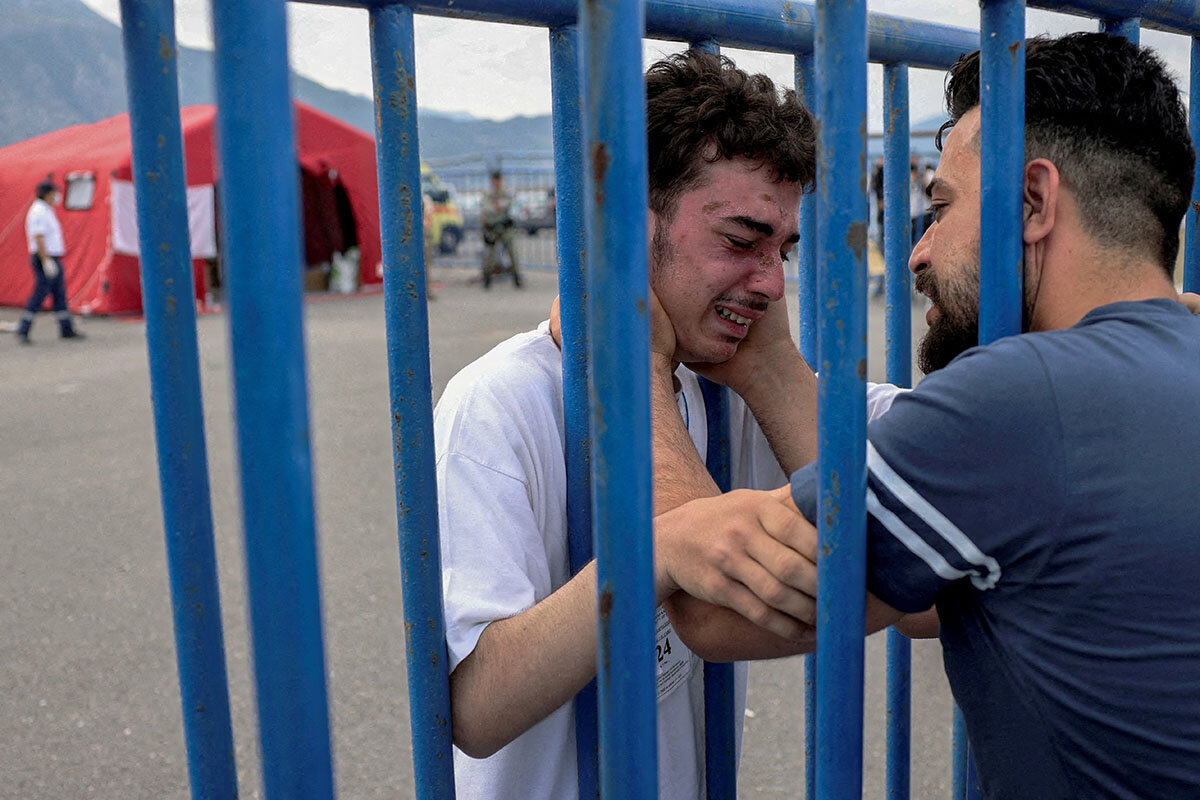
Now, the numbers are far higher. The catalysts are more complex. Some migrants are escaping the ravages of war; others are escaping religious or political persecution. Many are fleeing countries blighted economically by a combination of failed governance and the effects of climate change.
And there’s another critical difference. They’re clients – and victims – of what has become nothing short of an international industry: people trafficking.
Just as Israel bridles at accusations that it’s violating laws of war designed for a different kind of conflict than its battle with Hamas, European leaders are frustrated by the provisions of a 1950s refugee convention requiring a fair hearing, support, and care for those asylum applicants who do succeed in crossing their borders.
With once-fringe parties now making major gains on an anti-immigration message, European governments are looking to a combination of more stringent border controls and financial deals with countries along the migration routes simply to keep potential asylum-seekers out.
So will the “Gaza model” work here as well, forged by the countries most directly affected?
If so, it may begin to become clearer in the months ahead, as the European Union finalizes its first unionwide agreement on migration and asylum.
The agreement still has to go through debate, discussion, and potential changes in the European Parliament. But so far it seems to be shaping up as a mix of carrots and sticks: tougher border policies, better processing of those arriving, and quicker deportation for those not accepted, but also measures to ensure better settlement and support for those who are admitted. The hope is for all member states either to accept the migrants or to contribute financially to those settling elsewhere.
Yet with millions of migrants still on the move, the people traffickers thriving, and the political mood on migration toughening in many EU states, human rights groups have said the key test will be whether the EU’s emphasis on deterring, blocking, and returning migrants crowds out provisions to improve settlement and support.
In other words, whether, as in Gaza, the arrangement recognizes the enduring power of the core principle of both humanitarian covenants of 70 years ago – the need to protect fellow human beings unable to protect themselves.

On Film
Bring your appetite: Delicious documentary is a feast for the eyes
“Each cheese has its moment of truth.” Welcome to the world of haute cuisine, captured in the newest film by a legendary documentarian. Yet somewhere along the way, the film finds a story that touches much deeper than Michelin stars.
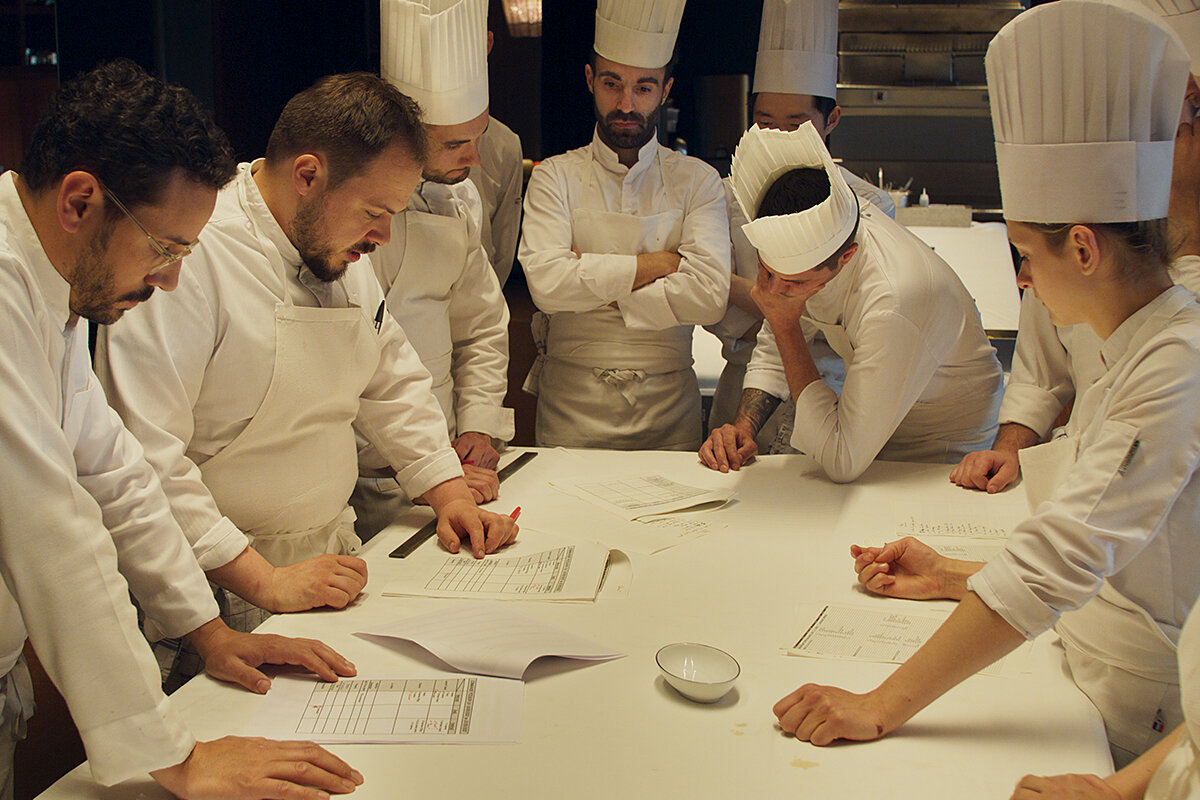
Bring your appetite: Delicious documentary is a feast for the eyes
Frederick Wiseman’s “Menus-Plaisirs – Les Troisgros” is a four-hour documentary about a legendary French restaurant, Le Bois sans Feuilles, in the bucolic Loire countryside. I wasn’t bored for a moment. To call it “immersive” is an understatement.
Foodie shows have been so overexposed on television that the effect of this film comes as something of a shock: For once, we are experiencing the culinary arts through the eyes of a master observer.
For almost six decades, and 44 documentaries, Wiseman has looked into the workings of institutions – high schools, juvenile courts, zoos, metropolitan hospitals, ballet companies, welfare offices, city halls, and much else. In practically every instance, what unfolds has the depth and amplitude of a major novel. He dispenses with narration, interviews, and scored music on the soundtrack. Events are presented without any editorializing or overt intervention. Wiseman’s vision in “Menus-Plaisirs” accumulates before our eyes, and it has a kind of purity. It’s as if we were looking at even the most commonplace things afresh.
The famed Troisgros restaurant was founded in 1930 and for four generations has been owned and operated by the family, earning a three-star Michelin rating for the past 55 years. Although the family runs several other establishments, the film’s primary focus is on Le Bois sans Feuilles. Its engagingly huffy maestro, Michel Troisgros, is preparing to hand over the reins to César, his eldest son and head chef. Almost imperceptibly at first, “Menus-Plaisirs” – which translates into English as “small pleasures” – becomes a family saga. The torch, rather ruefully, is being passed.
The daily operation of the restaurant for lunch and dinner is only part of the picture. But what an operation it is, as the crew prepares the menu for the day. They notate in advance the preferences and allergies of the guests, most of whom seem to be captivated by the soft splendor of the occasion. (One of the diners jokingly says, “My only allergy is to the bill.”)
The nouvelle cuisine recipes are tested and altered and worried over until perfection is achieved. Kidneys, passion fruit, rack of lamb, rhubarb, perch, frog legs, crawfish, snails, and lots more are examined with the kind of granular scrutiny one might expect from a high-stakes chemistry experiment. As Wiseman has said in interviews about the making of the film, which he also edited, the effect “was like being in the studio of great artists.”
Away from the restaurant, we see Michel, César, and his brother Léo scout the fresh vegetable market and local fishmongers. We look in on a backyard garden, an organic cattle ranch, a vineyard, and a cheese-processing plant. The cheese expedition is especially revealing. Wine aficionados have nothing on cheese mavens. “Each cheese has its moment of truth,” exclaims an expert in the cave where they are ripening.
What I wasn’t expecting as I watched “Menus-Plaisirs” was how moving it became. It transcends being a movie only about the culinary experience. Michel and his crew are indeed artists, and their perfectionist passion shines through everything they do. It’s the same kind of passion that informs Wiseman’s vast filmography and no doubt drew him to this world. At 93, he has an undiminished avidity for capturing workaday revelations. The people in his documentary have an almost pantheistic appreciation for the natural elements – the sea, the soil, and the seasons – that provide the life blood for their devotion. Guardians of an age-old tradition, they are also carrying that tradition forward. Clearly they are in awe of doing so.
What is so poignant about culinary art, especially as practiced at this level, is its transience. Masterpieces are created only to be consumed. It’s all a beautiful, sensual vanishing act. The workings of a food establishment are ostensibly what is on view here, but the movie is really about the passage of life.
Peter Rainer is the Monitor’s film critic. “Menus-Plaisirs – Les Troisgros” is not rated. It is in French with English subtitles.
Other headline stories we’re watching
(Get live updates throughout the day.)The Monitor's View
Peacemakers and Putin’s holy war
- Quick Read
- Deep Read ( 3 Min. )
-
By the Monitor's Editorial Board
In a speech Tuesday, Russian President Vladimir Putin reminded the world that his war in Ukraine has a second front – one not defined by military conquest. Speaking before a large group of clergy from the Russian Orthodox Church – and in front of images of Orthodox icons – Mr. Putin said Russian speakers everywhere constitute more than a nationality. Whether in Ukraine or elsewhere, they also have a “cultural, spiritual, and historical identity” as “part of the big Russian world.”
Mr. Putin’s speech reflects an acceleration of his attempts to justify the war as a “civilizational” cause, anchored by the central role of the Russian Orthodox Church as the traditional leader of many other Orthodox churches in former Soviet states. The Kremlin now speaks as much of a “holy war” as it does of patriotism.
Yet just as the Russian military has lost ground in Ukraine, so too is the Russian Orthodox Church losing the allegiance of Orthodox churches in neighboring countries from the Baltic states to Kazakhstan.
Peacemakers and Putin’s holy war

In a speech Tuesday, Russian President Vladimir Putin reminded the world that his war in Ukraine has a second front – one not defined by military conquest.
Speaking before a large group of clergy from the Russian Orthodox Church – and in front of images of Orthodox icons – Mr. Putin said Russian speakers everywhere constitute more than a nationality. Whether in Ukraine or elsewhere, they also have a “cultural, spiritual, and historical identity” as “part of the big Russian world.”
Mr. Putin’s speech reflects an acceleration of his attempts to justify the war as a “civilizational” cause, anchored by the central role of the Russian Orthodox Church as the traditional leader of many other Orthodox churches in former Soviet states. The Kremlin now speaks as much of a “holy war” as it does of patriotism.
Yet just as the Russian military has lost ground in Ukraine, so too is the Russian Orthodox Church losing the allegiance of Orthodox churches in neighboring countries from the Baltic states to Kazakhstan.
In Ukraine especially, many parishioners have switched to Orthodox churches not aligned with the one in Moscow, whose leaders back the war. A bill pending in the Ukrainian parliament would ban any religious group whose management is “located outside of Ukraine in a state that carries out armed aggression against Ukraine.”
Bulgaria has closed the Russian Orthodox Church for security reasons. In Kazakhstan, many Orthodox leaders are seeking official independence from the Moscow church. And in Moldova, a growing number of priests in the majority Russian-linked Orthodox church have asked it to switch allegiance to the Orthodox church in Romania.
“For our parishioners it is important to feel that we want peace and that the borders of all countries must be observed,” Moldovan President Maia Sandu told a radio interviewer. “The church cannot stay on the sidelines and pretend it does not see what is happening.”
Mr. Putin’s campaign to tie the war in Ukraine to the dominance of the Russian Orthodox Church could be more of a defensive move. Soon after the conflict started in early 2022, some 300 Russian Orthodox priests signed a public letter calling for peace in Ukraine. Several anti-war priests have been dismissed for their pacifist views. And Russian courts have convicted at least four people on criminal charges for opposing the war on religious grounds.
One of the most prominent anti-war priests is the Rev. Ioann Burdin in the Kostroma region northeast of Moscow. After being defrocked last March for his public prayers for peace, he told The Associated Press, “Since all people are brothers, then any war, any military conflict, one way or another becomes fratricidal.”
Another priest, Ioann Kurmoyarov, was sentenced in August to three years in prison for disseminating “false information” about the war effort. He told the court, “A Christian cannot look indifferently at the suffering of people, and especially children, regardless of what caused it.”
Perhaps such sentiments in Russia are why Mr. Putin, in his speech Tuesday, warned that “any attempt to sow ... religious discord, to split our society is betrayal, a crime against all of Russia.” Many Orthodox believers outside and inside Russia would beg to differ.

A Christian Science Perspective
Each weekday, the Monitor includes one clearly labeled religious article offering spiritual insight on contemporary issues, including the news. The publication – in its various forms – is produced for anyone who cares about the progress of the human endeavor around the world and seeks news reported with compassion, intelligence, and an essentially constructive lens. For many, that caring has religious roots. For many, it does not. The Monitor has always embraced both audiences. The Monitor is owned by a church – The First Church of Christ, Scientist, in Boston – whose founder was concerned with both the state of the world and the quality of available news.
Defined by God, not material history
- Quick Read
- Read or Listen ( 4 Min. )
-
By Lynne Buckley-Quirk
Sometimes the past can feel impossible to escape. But seeing ourselves and others from a spiritual perspective offers a foundation for reformation, healing, and a fresh start.
Defined by God, not material history
It can seem as though our identity is permanently defined by a material past, based on heredity, family status, education, health, regrettable decisions, etc. And yet, the Apostle Paul tells us that if we are “in Christ,” we are “a new creature” (II Corinthians 5:17).
Some Bible commentaries put forth the idea that to be “in Christ” is to be “united” with Christ. Christ Jesus, whose real, spiritual selfhood was the Christ, spent his ministry proving that God’s spiritual, eternal nature and power are ever present to save man from sin, disease, and death. When we unite with Christ, Truth, we look to God, Spirit, instead of the belief in a material past for our understanding of reality. As we do, we discover a new, truer sense of our identity as defined by God, not by our human history.
Mary Baker Eddy, the discoverer of Christian Science, writes in “Retrospection and Introspection,” “It is well to know, dear reader, that our material, mortal history is but the record of dreams, not of man’s real existence, and the dream has no place in the Science of being” (p. 21), and later, “The human history needs to be revised, and the material record expunged” (p. 22).
Is it really possible to expunge, or turn away from, the belief in an identity based in material history?
Before I started studying Christian Science as a young adult, I didn’t think it was. But with my study of the teachings of Christian Science came a realization that understanding our true identity comes with a deeper understanding of God. This begins with obeying what Christ Jesus referred to as the “first of all the commandments”: “Hear, O Israel; The Lord our God is one Lord: and thou shalt love the Lord thy God with all thy heart, and with all thy soul, and with all thy mind, and with all thy strength” (Mark 12:29, 30).
To understand that God is one God is to understand that He is infinite. He is the only. He is all good; all power; all presence; all intelligence. And therefore all that God, divine Principle, creates – man and the whole universe – is created good, complete, and perfect.
Turning away from a materially based sense of self clears the way for us to behold ourselves and others as God’s image and likeness. This freedom gives us a fresh new start!
We are endowed with the inalienable right to realize the Science of our being – our own true, spiritual nature and that of others – which naturally turns us away from, or expunges, a distorted, false sense of man as sinful or imperfect. This doesn’t mean we overlook wrongdoing, but it gives us a foundation for correction and reformation.
It is the Christ, the spiritual idea of divine Love, that consistently leads us to turn away from a materially based human history regarding our identity and toward the fact of our true spiritual identity and existence. Receptivity to Christ brings tangible blessings.
A good example of this Christ action can be found in Jesus’ parable of the prodigal son (see Luke 15:11-32). In the story, a brash young man demands that his father give him his inheritance. He leaves home, but because of his undisciplined and reckless behavior, he soon finds himself with no money and so hungry that he is tempted to eat what was normally fed only to swine.
It is at this most humiliating moment that he comes “to himself” – comes to the realization of his identity as his father’s son. But he is filled with remorse for his sinful past, so with deep repentance, he decides he no longer has the right to claim his status as the son of a wealthy estate owner. He resolves to return home not as his father’s son, but as a humble servant. However, he is immediately received as a son by his father, whose response reflects unconditional love.
The Christ comes to every humble, penitent heart and reveals our true, spiritual identity – allowing us to come to ourselves, to conform to who we truly are. We see that spiritually we are embraced with open arms, every moment, by God – as citizens of our Father’s kingdom, where a materially based history does not define us.
And as we realize that our true identity is governed by the law of God, our experience reflects more of the universal harmony and peace of the kingdom of heaven – “all things are become new” (II Corinthians 5:17).
Adapted from an article published in the August 2016 issue of The Christian Science Journal.

Viewfinder
Seeing red
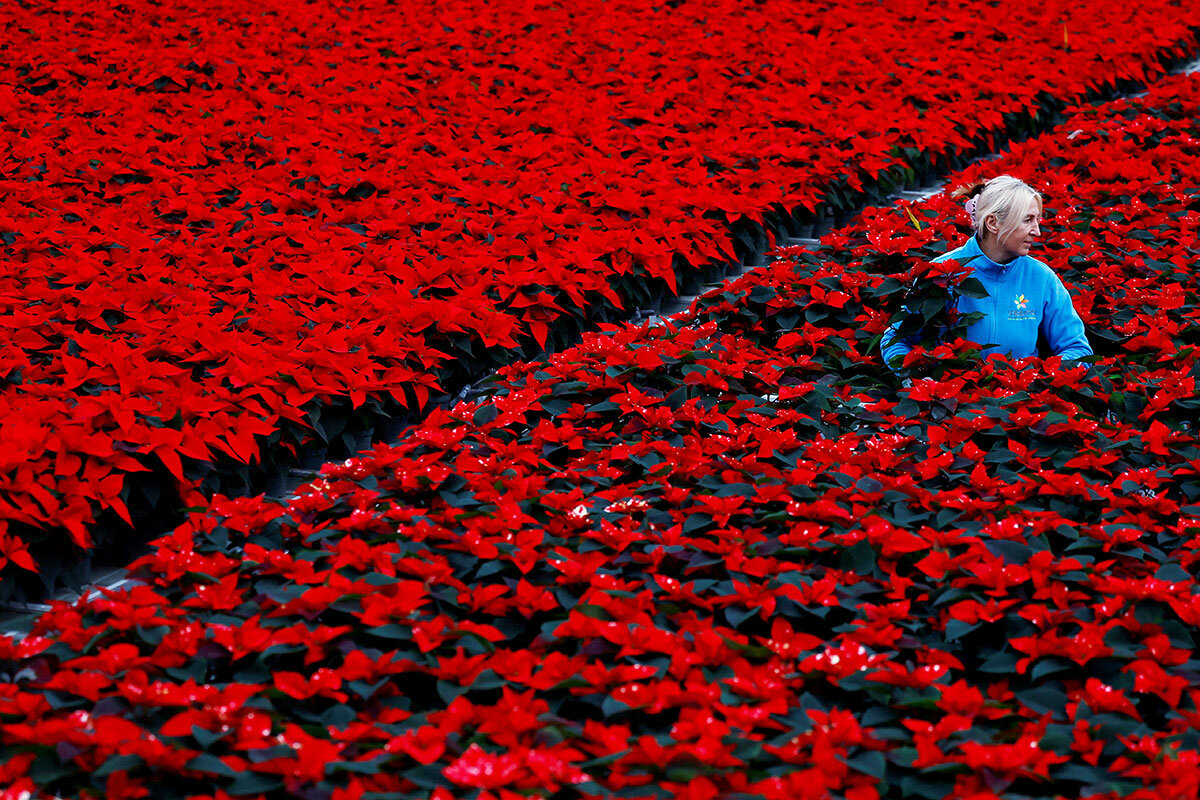
A look ahead
Thank you for joining us today. Tomorrow we’ll take a closer look at language in Ukraine. Many Ukrainians are bilingual, so the language they speak is a personal decision. And at a time of war, it’s an emotionally charged topic.
We’re also following the events on Capitol Hill in Washington, where the House is gearing up for a vote to expel Republican Rep. George Santos.


